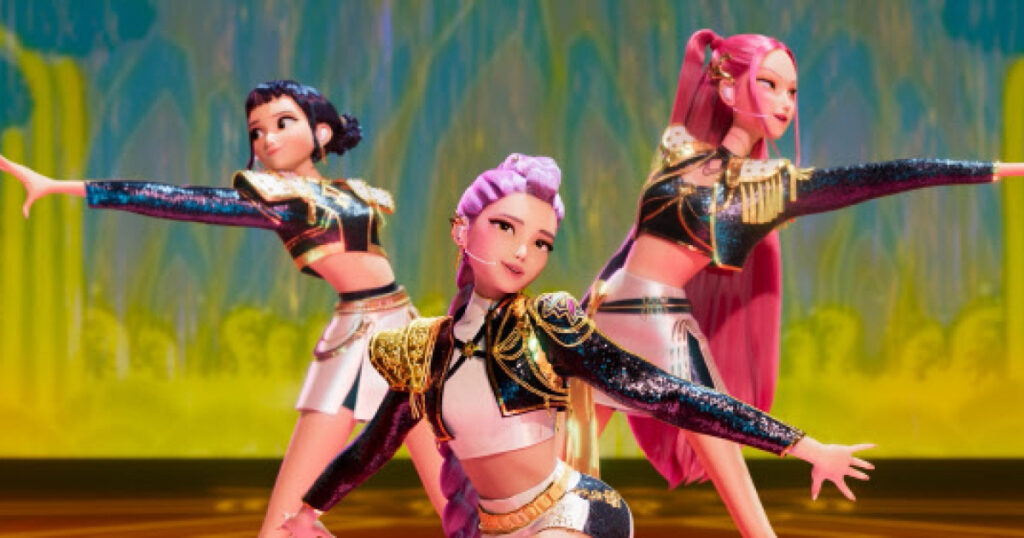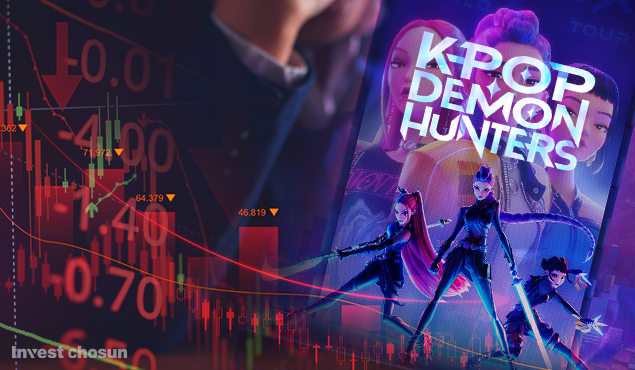Executive Summary: The K-Pop Demon Hunters Imperative

K-Pop Demon Hunters has emerged as a landmark case study in modern entertainment, transcending its genre to become a global cultural and economic phenomenon. Released on June 20, 2025, as a Netflix original American animated film, the movie represents a paradigm-shifting creative and strategic collaboration between Sony Pictures Animation and Netflix. This report argues that the film’s success is a direct result of a new “trans-national” content model, where cross-cultural elements are not merely integrated but are fundamentally fused to generate unprecedented success across multiple, distinct metrics. This model has led to record-breaking viewership, a chart-topping musical soundtrack, and tangible economic benefits, including a significant surge in cultural tourism to South Korea.
Central to this phenomenon is the “fankonomy,” a new economic model where the film’s engaged global fanbase evolves from a passive consumer base into a self-sustaining, value-creating engine. This decentralized, fan-led amplification has proven to be a more powerful and organic marketing force than traditional top-down promotional campaigns. The analysis presented here will demonstrate how
K-Pop Demon Hunters challenges conventional intellectual property creation and monetization strategies, showcasing a future where entertainment properties are designed to facilitate fan-driven creative ecosystems.
Section I: Genesis of a Global Phenomenon: The Creative and Strategic Blueprint
1.1. The Birth of a Hybrid: A New Model for Global Content Production
K-Pop Demon Hunters holds the distinction of being the first foreign-produced animated feature film to center on K-pop idols and the first musical animation to exclusively use K-pop music. This foundational status establishes the film as a strategic anomaly from its very conception. The creative vision was driven by director Maggie Kang’s deeply personal goal of crafting a “love letter to Korean culture,” with her and fellow director Chris Appelhans bringing this vision to life. The film also benefited from a star-studded voice cast that added depth and humor to the characters, including Arden Cho, Ahn Hyo-seop, May Hong, Ji-young Yoo, Yunjin Kim, Daniel Dae Kim, Ken Jeong, and Lee Byung-hun.
The film’s journey to the screen was marked by a high-stakes strategic decision. After approximately 4.5 years of production by Sony Pictures Animation, the studio chose to license the film to Netflix for global distribution rather than pursuing a traditional theatrical release. This decision, which at the time may have seemed risky, has since been framed as a prescient move that proved the old Hollywood adage, “Nobody knows anything”. By leveraging Netflix’s powerful global distribution platform, the film was able to bypass conventional market pressures and build an organic groundswell of momentum, an approach that would have been far more difficult within the traditional theatrical release window. This strategic partnership between a major American studio and the world’s leading streaming service established a new blueprint for releasing a major intellectual property, prioritizing direct-to-consumer reach over conventional box office models.
1.2. Narrative as a Hybrid Art Form: Blending Pop Culture and Ancient Lore
The film’s core narrative follows Huntr/x, a K-pop girl group who use their secret abilities to protect their fans from supernatural threats, and their main antagonists, the Saja Boys, a rival boy band who are secretly demons. At its heart, the story explores the central conflict of Rumi, the group’s leader, who must reconcile her secret demon heritage with her duties as a hunter, a journey that intertwines with her relationship with Jinu, the leader of the Saja Boys. The film’s central message of overcoming shame and embracing self-acceptance provides a resonant emotional core beneath the vibrant spectacle.
However, the film’s narrative has prompted a fascinating divergence in critical and fan opinion. Some professional critics, applying traditional Western narrative standards, have dismissed the plot as “silly,” “predictable,” and “cringey,” arguing that its characters are “paper-thin” and that the writing is “amateurish”. From this viewpoint, the film’s fast-paced story and shallow relationships detract from its emotional weight. The dialogue has been criticized as basic, and the climax is seen by some as contradicting the film’s own message about the non-inherent evil of demons. Conversely, a dedicated and highly engaged fanbase and other cultural commentators view the film as a rich tapestry of mythological symbolism and subtle world-building. For them, the narrative’s strength is its fusion of familiar tropes, such as the hero’s journey and enemies-to-lovers dynamic, with a rich subtext of cultural allusions. For example, fan discussions on platforms like Reddit have identified potential connections between the main characters and the Four Auspicious Beasts of Sino-Korean mythology, where Rumi is linked to the White Tiger, Zoey to the Azure Dragon, and Mira to the Black Tortoise. This depth is not presented overtly but is woven into the film’s visual language and character design, leaving ample space for fan interpretation and world-building. This model demonstrates that a modern, globally resonant film can prioritize a visually and aurally stimulating experience with a loose narrative framework that is ripe for fan-driven expansion, rather than relying on a dense, tightly-woven plot.
Section II: The Symbiotic Cultural Nexus: From Screen to Society
2.1. The Mythology of Modernity: Bridging Tradition and Pop
The success of K-Pop Demon Hunters lies in its masterful and respectful integration of Korean folklore and mythology into a modern K-pop setting. The film reinterprets traditional shamanistic rites (mudang), where shamans used dance and song to ward off evil, as the modern stage performances of K-pop idols. This unique narrative device connects ancient spiritual practices to contemporary pop culture, creating a story that is both original and deeply rooted in its source culture. The film also features iconic figures from Korean folklore, such as the tiger, which has been a powerful cultural symbol for generations, and the Haetae, a guardian beast known to protect against evil. The magical barrier that seals away the demons is called the Honmoon (“soul-gate”), a term drawn from Korean myth. A fan theory suggests that the film’s depiction of the barrier’s evolution from a local, imperfect seal to a global “Golden Honmoon” is a metaphor for the rising global influence of K-pop. The film’s narrative boldly fuses these traditional elements with a Christian-influenced demonology, resulting in a narrative that is both “trans-religious” and “trans-ideological” and thus universally accessible.
The film’s attention to detail extends to its characters and locations. The creators deliberately started with an all-Korean trio not just to ground the story in tradition but to leave room to explore how K-pop has evolved. The character designs are also filled with subtle tributes; for instance, the Huntr/x trio’s outfits and visual motifs are linked to pioneering first-generation K-pop groups like The Kim Sisters, The Hee Sisters, and S.E.S.. Furthermore, the film’s fictional lore draws on specific Korean geography. The Huntr/x members are said to have received their powers from Jeju Island, a place with numerous goddess myths and folklore, solidifying the film’s authentic cultural roots. This successful cultural synthesis has been a powerful engine for a new wave of interest in Korean traditions.

2.2. The Fandom as a Creative Engine: The Rise of the “Fankonomy”
The film’s success can be largely attributed to the emergence of the “fankonomy,” a new economic model where the fandom evolves from a passive consumer base into an active, value-creating “prosumer” force. The film did not just attract viewers; it inspired a wave of creative content. The “Golden Challenge,” where fans attempted to replicate the theme song’s difficult high notes, and the proliferation of dance covers, fan art, and social media memes, all served as a form of organic, viral marketing that expanded the film’s reach far beyond official promotional efforts.
A compelling example of this phenomenon is the “yeongwonhi” trend. The film’s theme song, a mix of English and Korean, features the Korean phrase “영원히 깨질 수 없는” (yeongwonhi kkaejil su eopneun), which translates to “forever unbreakable”. In a viral video, foreign fans enthusiastically sang along until they reached this Korean lyric, where the singing abruptly went quiet. This moment of collective silence sparked a massive, decentralized, fan-led effort to search for the meaning and proper pronunciation of the phrase. As a result, typing the Romanized spelling of “yeongwonhi” into search engines now automatically brings up the full lyric as a related term, and new videos explaining the correct pronunciation have appeared. This unique event created a self-sustaining feedback loop where the film’s content inspired fan activity, which in turn generated new content and marketing, driving new viewership and engagement. It demonstrates that a new content strategy must prioritize facilitating fan creativity, as the fankonomy is a powerful, low-cost marketing force that can turn a hit into a genuine cultural phenomenon.
2.3. Reshaping Cultural Perception: From Fiction to Reality
The film’s impact on global perceptions of South Korea has been immediate and quantifiable. The film has acted as a “soft power multiplier,” where the cultural narrative drives not only intangible appreciation but also tangible economic activity across multiple sectors, most notably tourism. For instance, data from the National Museum of Korea reveals a significant surge in visitors, with cumulative attendance from January 1 to August 25, 2025, reaching over 4.18 million, already surpassing the previous year’s annual total. Officials attribute this boom to the increased interest in traditional artifacts like the “gat” (traditional Korean hat) and the symbolic tiger, both of which appear in the film. The phenomenon has also extended to merchandise, with the museum’s “Magpie and Tiger Badge” and the popular Derpy doll inspired by a Joseon-era folk painting, selling out and prompting “open runs” where fans line up before the museum opens.
The film has also reshaped the tourism landscape, turning on-screen locations into must-visit sites. Social media posts mentioning Seoul’s Naksan Park, where the main characters Rumi and Jinu first meet, nearly doubled between June and August. Travel platforms have reported significant increases in bookings for cultural experiences, with demand for K-pop dance classes surging by 400 percent for American tourists and 575 percent for Taiwanese visitors. Furthermore, the film has influenced culinary trends, with fans embracing the comfort foods enjoyed by the characters, such as
gimbap and instant noodles. Recognizing this, major Korean food companies like Nongshim have launched special edition products featuring the film’s characters, directly linking the intellectual property to consumer goods and highlighting the immense value of this content-driven tourism and retail model. A government survey found that over 32% of inbound visitors were inspired by popular Korean content, underscoring how this entertainment property functions as a de facto cultural diplomacy and marketing tool with far-reaching economic benefits. The global interest in the film’s characters has led to commercially successful character IP, such as the Derpy tiger doll and a magpie doll named Seo Ssi, which were previously traditional motifs.
Section III: The Financial and Market Impact: Metrics of a Modern Blockbuster
3.1. Record-Shattering Metrics on the Global Stage
The film’s unprecedented success is best demonstrated through a multi-faceted analysis of its key performance indicators across different media platforms. On Netflix, K-Pop Demon Hunters set a new record by becoming the most-viewed film in the platform’s history, accumulating 236 million cumulative views and surpassing the previous record held by Red Notice. When including TV shows, the film ranks as the third most-watched title ever, positioned behind only
Squid Game and Wednesday. The film also proved its viability beyond streaming, with special “sing-along” theatrical screenings in North America grossing a weekend box office of $16 million to $22 million, demonstrating its hybrid success and strong fan engagement in a live setting.
The film’s critical reception has been highly favorable, with a Certified Fresh rating of 97% on Rotten Tomatoes, placing it on par with critically acclaimed animated films like Spider-Man: Into the Spider-Verse and The Mitchells vs. The Machines. It has also maintained a high IMDb score of 9.2/10. The film’s success has even drawn attention from major studios like Sony, which is now in negotiations for a potential follow-up to the franchise, with analysts noting that the film’s performance has given Sony leverage in future deals with streaming platforms like Netflix, Amazon, and HBO.
